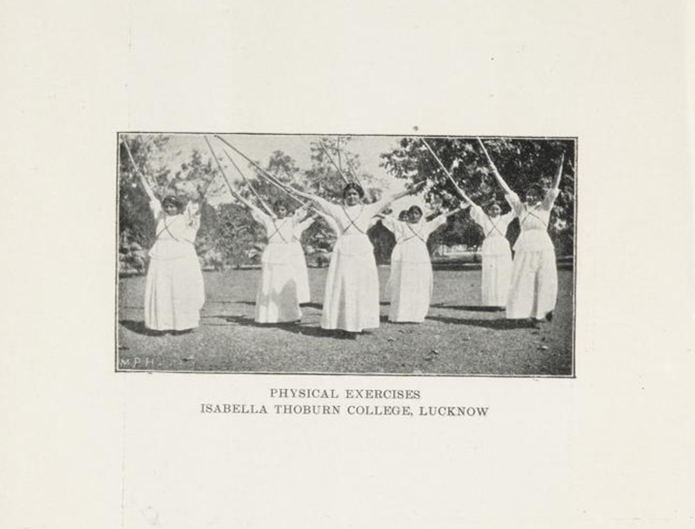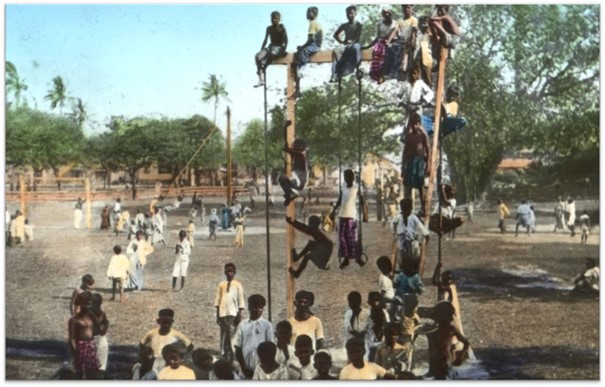Elena Valdameri
Project 1
Training Female Bodies, Making Good Citizens: Women’s Physical Education between Global Trends and Local Politics in India (1900s – 1950s)
This project examines the role of physical education and outdoor activities for girls and women in late colonial and early independent India as a part of broader modernizing projects that focused on the body as a site of political intervention. In the period under purview, having fit and vigorous bodies signalled a civic virtue and a means of modern self-expression. However, the bulk of existing literature dealing with the perceived importance of being physically fit has largely focused on boys and men, in particular Hindus of the upper castes, and on the forging of a muscular and masculine – and sometimes racialized – nation through bodily regimes. Against the odds of a largely male archive and record, Training Female Bodies wants to correct this predominantly masculine lens showing that from as early as the 1900s Indian women too were targets of, and claimed for themselves, physical fitness schemes to attain a healthy and strong body for similar and different reasons than men. The project also points to the need of moving away from national or imperial lenses. These, in fact, have occluded the global and transimperial interconnections and border-crossing trajectories at play when analysing the history of the body and of physical culture in (post)colonial settings like the Indian one.
The research investigates the physical fitness initiatives promoted by a variety of Indian and non-Indian historical actors as instruments to ‘uplift’ women and make them loyal subjects/citizens; it reconstructs the local and global (pseudo-)scientific theories and medical knowledge that underpinned gender stratified discourses, notions and practices of physical education; it finally examines how women actively claimed exercise and physicality as their own right and to what extent they could challenge subordination to colonialism, patriarchy and casteism in a period of political flux.
Overall, the research moves beyond compensatory narratives of Indian women’s sport histories to enquire how physical activity could offer women and girls control over their bodies and their individual, social and political lives. A deep engagement with this question can explain how gender is (re-)constituted with physical culture itself, consolidating femininity as a performance of docility or opening possibilities of resisting traditional gender constructs. Acknowledging the importance of race, ethnicity, caste, class and age as analytical lenses, Training Female Bodies takes account of the many fault-lines and fractures within the ‘woman’ category in India and examines if, how and when physical exercise (as leisure, competitive sport or national mobilisation) played a role in challenging or reinforcing such divisions.
Relevant publications
Valdameri, E. (2022). “Training Female Bodies for New India: Women’s Physical Education between Global Trends and Local Politics in Colonial South Asia, c. 1900–1939”. The International Journal of the History of Sport, 39 (11), 1240–1264. external page https://doi.org/10.1080/09523367.2022.2134349
Valdameri, E. (2024). “Purdah, national degeneration, and pelvic politics: women’s physical exercise in colonial India (ca 1900–1947)”, in Bodies beyond Binaries in Colonial and Postcolonial Asia, ed. by Kate Imy, Teresa Segura-Garcia, Elena Valdameri and Erica Wald, Leiden: LUP, pp. 197–226.

Project 2
Shaping Asian Future Generations in an Age of (De)Colonisation: Playgrounds and outdoor games in India and China (ca 1900s–1950s)
Funded by the Swiss National Science Foundation
This project explores the emergence of playgrounds as broadly educational and political sites in India and China in the first half of the 20th century. Playgrounds, understood as outdoor spaces specifically designed for children and equipped with elements for play, originated in North America and Europe in the last decade of the 19th century. Aimed at creating a safe place for ludic activities in large cities, playgrounds were based on the concept of supervised play as a tool to shape ‘healthy’ bodies and minds according to different ways of thinking of childhood.
Through the various imperial highways, playgrounds travelled to India and China where childhood acquired a new place in projects of humanitarian/imperial ‘rescue’ as well as in nationalist reformist agendas. In the vexed contexts of imperial domination, anticolonial nationalism and nation-building, the shaping of future generations grew into a concern across the colonial/anticolonial divide and throughout the political spectrum. Against this background, playgrounds became transimperial contact zones where children were supposed to be moulded into moral adults according to different agendas and theories of childhood.
With a special focus on Calcutta, Bombay, Madras, Hong Kong and the Shanghai Settlement, Shaping Future Generation seeks to reconstruct the web of transnational actors and globally circulating educational/pedagogical theories and practices that valued playgrounds as crucial spaces for the development of ‘healthy’ children and ‘good’ would-be adults. The project intends to contribute towards a more integrated picture of these spaces correcting the fragmentary, strongly West-centric and nation-bound existing scholarship while enriching the global history of childhood and of children’s geographies. The main goals are:
1. Exploring playgrounds in terms of discourse, knowledge, practices and subjectivity to investigate how childhood and youth were seen, produced and lived in the context of imperialism and nationalisms in urban Asia;
2. Identifying the specific features and similarities in playgrounds across the urban settings under study and in relation to Western countries considering the global actors, transimperial dynamics and the local agency involved in their creation;
3. Answering the question if playgrounds had a liberating function for children or rather contributed to a wider project of governmentality by making them conform to social norms and expectations.
The period under purview allows to examine the role played by playgrounds across the emergence of nationalism, the two World Wars, China’s occupation by the Japanese, the establishment of the People’s Republic, India’s independence from Great Britain and Hong Kong’s reoccupation by the British. While paying respect to the specific conditions applying to each case study, this time frame enables us to account for the continuities and discontinuities in the relationship existing between the historical actors, visions and practices revolving around the playground throughout these major historical shifts.

